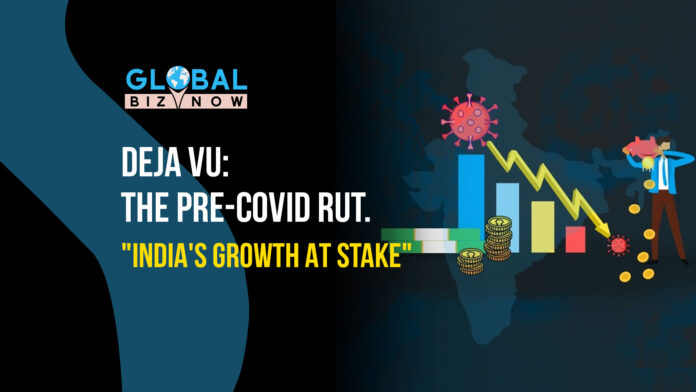India, the world’s fifth-largest economy, is celebrated for its resilience and rapid growth. However, cracks are starting to appear in India’s economic armor. Even after promising post-pandemic rebounds, it now stands at a critical juncture: stalled private investments, a jobs crisis, and uneven economic recovery.
These challenges risk pulling India back into the pre-Covid-19 rut, implying that the current situation is reverting to old, unproductive, or undesirable ways rather than embracing positive change or innovation introduced during or after the pandemic.. Alarmingly, economic decision-makers seem reluctant to acknowledge the slowdown, a stance that could hinder timely corrective action and cost the nation dearly.
The Numbers Behind the Slowdown
Private Flowing Investments
The Reserve Bank of India said that private sector capital expenditure or CapEx, increased only 4.8% in FY2023 while registering double-digit growth before the pandemic.
Gross fixed capital formation, a barometer of investment activity, in India continued to hover around 32.3% of GDP during FY2023, which is significantly lower than the level required for sustainable growth at 35%.
Rising Unemployment
The unemployment rate continues to be a matter of concern and in October 2023, stood at 8.4%, the Centre for Monitoring Indian Economy reported.
The rural labor force remains heavily reliant on assistance from the government: For example, when the Mahatma Gandhi National Rural Employment Guarantee Act was in place, demand for work increased by 20% in 2023-an indication of weak rural employment creation.
Uneven Recovery
Corporates earned profits of more than Rs 8.8 lakh crore in FY2023, while MSMEs, which provide 30 per cent to India’s GDP and employ over 110 million people, are unable to recover from losses.
The World Inequality Report of 2022 indicates that income inequality has increased and that more than 57% of the wealth in the country is by the top 10%.
Weak Consumption Demand
Private consumption, 58.4% of GDP, has also reflected the signs of exhaustion. It grew only at 6.4% in FY2023 compared with 7.9% in the last fiscal year.
The Pre-Covid Rut: Déjà Vu?
There are many telltale signs that India is slipping back into a pre-Covid-19 rut.
It grew at 4.2 percent in FY2020, the weakest pace over a decade, dragged by weak investments and declining consumption.
The trends continue even after the pandemic, with IMF and World Bank projections lowering India’s GDP growth for FY2024 to 6.1% and 5.9%, respectively.
The Dangers of Denial
India’s reluctance to squarely address these economic issues might have the following backlash:
Lost investment opportunities
In fact, China-plus-one strategies may provide one-time global rebalancing of supply chains such that India can attract manufacturing investments. However, Vietnam and Indonesia are not hesitant to take advantage by offering targeted incentives as well as ease of doing business reform.
Growth jobs
If no jobs are created, the demographic dividend might easily turn into a liability. While over 140 million people will join India’s workforce by 2030, at current trends, they would simply lack adequate opportunities.
Erosion of Consumer Confidence
The prolonged economic stagnation reduces household incomes, thus reducing consumer spending, part of which consumes more than half of the economy. This in turn further weakens the recovery cycle.
What India Must Do: A Prescription With Data
Resurrect Private Investments
Incentivize the respective industries by offering tax breaks in capital expenditure on high-employment sectors such as manufacturing, renewable energy, or logistics.
Public-Private Partnerships: Leverage PPPs more in infrastructure to bring in private capital. Rs.111 lakh crore National Infrastructure Pipeline remains an important opportunity for such partnerships.
Expand Employment Opportunities
Skill Enhancement Initiative Scaling up programs like PMKVY or the Pradhan Mantri Kaushal Vikas Yojana is to equip the workforce in high-demand areas, for example, digital services, and green technologies.
MSME lending: Targeted credit guarantees for the sector of MSMEs, who constitute more than 40 percent of India’s workforce but not access affordable finance.
Strengthen consumption demand
Rationale of GST: Reduce the GST rate on essentials so that they become cheaper and increase demand.
Cash Transfers: Increase direct benefit transfers for low-income households to encourage grassroots consumption.Tap Global Supply Chains International players need to be brought in through PLI schemes that expand into emerging sectors like electronics and pharmaceuticals.
Clear Representation Data-Driven Communication: Recognize the slowdown and engage stakeholders with concrete data and action plans. This will surely improve investor confidence and encourage collaborative problem solving.
Why is the hour to act now?
The hope of India’s becoming a $5 trillion economy by 2027 will depend on getting over these structural challenges. The global economic climate is still uncertain, but the size of the domestic market, the young workforce, and the technological potential are unique advantages for India.
But only if there is swift and decisive action: Recover, resimulate: this is the moment to rethink, recreate, and rebuild an economy more resilient, inclusive, and sustainable.
Align with Global Trends
Utilize global trends of digital transformation, green energy, and all other geopolitical shifts to leverage competitive positioning for India as a global investment and innovation hub.
From Sacrifice to Growth India cannot afford squandering growth potential by ignoring an economic slowdown. Now, there are clear signs of underlying vulnerabilities in the absence of meaningful private investment, weak job creation, and tepid consumption demand. Answers are nigh-strategic reforms, targeted investments, and transparent governance can set the growth wheel rolling again in India. It is time for India to seize this opportunity when the world is watching. With these challenges, India will regain momentum in growth and solidly establish its position as one of the top economic superpowers of the world. It is the time for policymakers, business leaders, and citizens to act.


